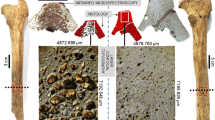Abstract
PREVIOUS work on strontium estimation in biological material has involved the use of optical emission spectroscopy1 and name spectrophotometry2, both of which suffer from the disadvantage that the sample is destroyed during the analysis. This can be a significant factor when, in the interest of precision, the analysis must be repeated several times on each sample, when the quantity of material from any particular region of a bone is small, or when the sample is to be used for radiometric estimation of strontium-90.
This is a preview of subscription content, access via your institution
Access options
Subscribe to this journal
Receive 51 print issues and online access
$199.00 per year
only $3.90 per issue
Buy this article
- Purchase on Springer Link
- Instant access to full article PDF
Prices may be subject to local taxes which are calculated during checkout
Similar content being viewed by others
References
Thurber, D. L., et al., Science, 128, 3318 (1958).
Harrison, G. E., Nature, 182, 4638 (1958).
Youden, W. J., “Statistical Methods for Chemists” (Wiley, 1955).
Author information
Authors and Affiliations
Rights and permissions
About this article
Cite this article
ROBERTS, W. Estimation of Strontium in Animal Bone using X-ray Fluorescence Analysis. Nature 183, 887–888 (1959). https://doi.org/10.1038/183887a0
Issue Date:
DOI: https://doi.org/10.1038/183887a0
This article is cited by
-
Quantitative imaging of gold nanoparticle distribution in a tumor-bearing mouse using benchtop x-ray fluorescence computed tomography
Scientific Reports (2016)
-
Zur R�ntgen-Fluoreszenz-Spektralanalyse von Rubidium, Strontium, Barium und Blei in Kaolinen und Tonen
Contributions to Mineralogy and Petrology (1966)
-
X-ray Spectrographic Determination of Strontium
Nature (1959)
Comments
By submitting a comment you agree to abide by our Terms and Community Guidelines. If you find something abusive or that does not comply with our terms or guidelines please flag it as inappropriate.



